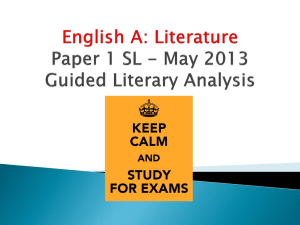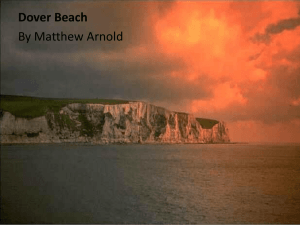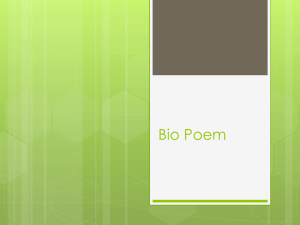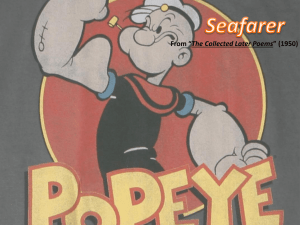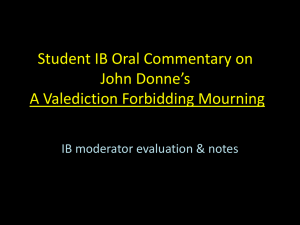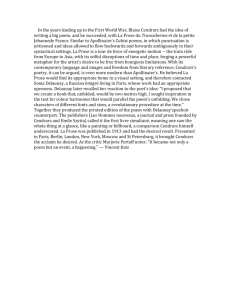Paper 1 Written Commentary - IB English Literature 2012-2013
advertisement
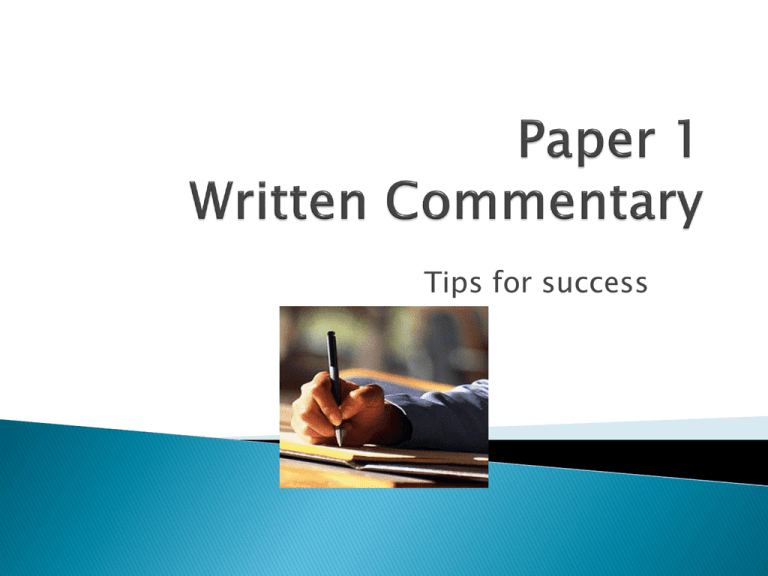
Tips for success Times and dates of examination First exam – 2nd May 2012 Timing Higher – 2 hours Standard – 1 hour 30 minutes A poem and prose passage. You must choose one. Read both. Then choose. Prose Either a An extract from a novel or short story An essay A biography A journalistic piece of writing Normally excerpts are from novels and short stories. Other forms chosen will have techniques used by writers which are common in novels and short stories e.g. Use of comparison, similes, metaphors. Later on we will look at a prose passage from ‘The American Scholar’ . Whole range of poems used. A lot are modern and use free verse However some are pre 20th and 21st century – glossaries often given. Look at title and collection it is taken from for clues. Sometimes they give a date. Older ones are likely to use a set structure for stanzas and rhythm. Never read too much into title of collection e.g. ‘Daughters of Africa’- poem called ‘Points of View’. The poem was about the role of water and how we view it – nothing essentially to do with the title. If the poem is long the examiner will consider this when marking.e.g. ‘Child and Insect’ – Standard 2005 May They will then not expect candidates to examine every aspect of the poem but to be selective. 5 minutes reading time – read prose carefully – if standard reading guiding questions before you start to read each piece. 5 minutes – read poem carefully. Weigh it up carefully , but also consider which form you have had success with previously. Once you have selected one start to read through again making annotations. If standard you could write notes in terms of g.q.s. This is an option – remember wording. You do not need to look at q.g.s If higher the most important elements of the piece must be identified. e.g. ‘Regeneration’ – the main character’s reflections. Then read the text for the third time. Standard Reading /annotation – 5 minutes of reading time and 10-15 minutes. Planning – paragraph by paragraph – 5-10 minutes. Start writing after 2025 minutes . Higher Reading /annotation – 5 minutes of reading time and 15/20 minutes . Planning – paragraph by paragraph – section by section – 10 minutes Start writing 30 -35 minutes- no GQs – so prep takes longer. Five Assessment Criteria-all worth 5 A -Understanding of the text – you must read the text carefully at least 3 times to do well in this. Example 1 – Your mock paper of Jan 2011, where students seemed to focus just on lines 1-22 and not the entire extract. Example 2 – ‘The Loom’ -2005 – students missed that 5 not 4 daughters were mentioned. Regeneration – ignoring reference to bullets. . Literary texts can be interpreted in different ways. There is often a surface meaning and a deeper meaning. The wording in this category includes – the candidate’s ideas are relevant and include a personal response. As an ‘examiner’ I come across interpretations I had not seen or considered. If they were defended ( using quotations too) and relevant I awarded them. Do not look at a text, come up with a personal interpretation and let it control your whole commentary. Example – 2005 poem – The Wasp’s Nest’ . The poem centred on a narrator/speaker commenting on a wasp’s nest in his/her mailbox. There is conflict as the speaker wants her mail and the wasps want a residence. A few students decided it represented the conflict between the USA and Russia during The Cold War . They then tried to defend it by misinterpreting the whole text. One sentence may have been relevant e.g. This is a microcosm of what happens in the world such as superpowers fighting for supremacy. You cannot comment on every feature. However, a sound commentary would refer to literary features regularly .Candidates seem to find it easier to comment on effects in poetry. If you opt for poetry you must be able to comment on structure and form too if appropriate. If you are still unsure about these talk to your teacher. Points for prose e.g Characterisation Idioms Themes Choice of diction - Use of metaphor, simile, personification,onomatopoeia – perhaps even semantic fields e.g. The use of sea imagery Syntax Paragraphs/structure Suspense,tension,conflict Creation of atmosphere Use of dialogue/narrative Listing These are not in isolation e.g. The use of a particular metaphor may create an atmosphere or tone to the piece. May 2005 – ‘The Loom’ by Sasaki The progression of colours ( technique – C) throughout the extract and the narrator’s appeal to our senses ( A/B) brings the reader closer to the actual experience that the mother’s loom weaves ( A). The mother begins weaving with the ‘subdued and muted colours she liked ’. So instantly the colours symbolise her character and emotions ( B/E). The word ‘subdued’ is one that can be ascribed to a state of mind. The writer’s use of ‘muted’ is interesting as the mother says nothing throughout the extract. (B) ‘In the Rear-View Mirror’ by Shaw – Nov 2008 The structure( c) of the poem is particularly significant as it links to the speaker’s view that images are stored in our memories (b). The first word ‘thinking’ in the opening line; ‘Thinking about them as you saw them last’ (b/d) pinpoints that the poem will be a reflective/contemplative piece . The rest of the line highlights that the narrator is analysing his memory of the ‘last’ time he saw his parents. At the conclusion of the poem Shaw replicates the line but changes ‘last’ to ‘lasting’. The subtle change in tense (e) implies his memory will be ongoing. This is organisation of your ideas and how well supporting examples are integrated into the body of the commentary. If you feel safer go for a line-by-line approach or section by section. If you are confident and in the past have been successful try a different approach. Standard students can use a response to the guiding questions as a plan. Remember you can delete sentences/phrases when you proofread at the end. No notes / shorthand No colloquialisms/slang/informal speech Spelling/use of capital letters/grammar must be accurate. The American Scholar Prose passage 2008 November– the passage explored the significance of the heart to humanity and the world around us. The writing was at times factual ( non-fiction) and at others more poetic ( creative non-fiction) . The author used a mixture of non-fiction and creative non-fiction. E.g. non-fiction. ‘The biggest heart in the world is inside the blue whale’. Creative non-fiction ‘that all hearts finally are bruised and scarred,scored and torn’ - where the heart is personified. The mark scheme talked about the mixture of scientific and reflective commentary . Various dictions e.g. quantitative hundred gallons of milk Scientific – Unicellular bacteria Emotive – penetrating moaning cries Choose your own 50-70 line prose extract. This could be from any text (Perfume, Dr.Jekyll, journal, autobiography etc) You’ll need to annotate the extract and be repared to present your analysis via a PowerPoint or Prezi presentation. Two of you will be selected to present to the class next Tuesday. Remember your focus in on language analysis and defending your ideas appropriately. I will need a copy of your extract to distribute to the class if you are chosen to present. GOOD LUCK AND ENJOY THE CHALLENGE
